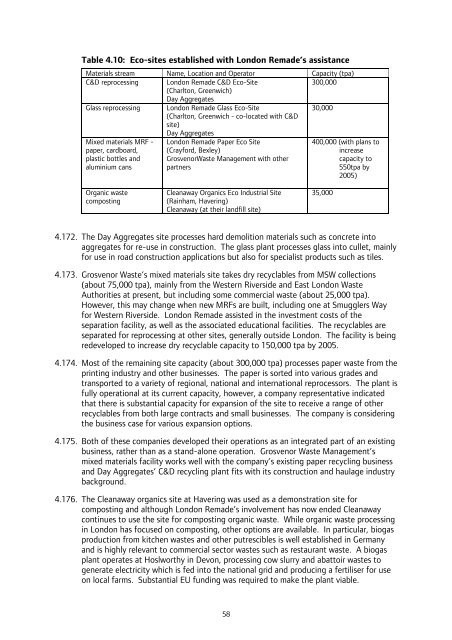London Wider Waste Strategy - London - Greater London Authority
London Wider Waste Strategy - London - Greater London Authority
London Wider Waste Strategy - London - Greater London Authority
Create successful ePaper yourself
Turn your PDF publications into a flip-book with our unique Google optimized e-Paper software.
Table 4.10: Eco-sites established with <strong>London</strong> Remade’s assistance<br />
Materials stream Name, Location and Operator Capacity (tpa)<br />
C&D reprocessing <strong>London</strong> Remade C&D Eco-Site<br />
(Charlton, Greenwich)<br />
Day Aggregates<br />
300,000<br />
Glass reprocessing <strong>London</strong> Remade Glass Eco-Site<br />
(Charlton, Greenwich - co-located with C&D<br />
site)<br />
Day Aggregates<br />
30,000<br />
Mixed materials MRF - <strong>London</strong> Remade Paper Eco Site<br />
400,000 (with plans to<br />
paper, cardboard, (Crayford, Bexley)<br />
increase<br />
plastic bottles and Grosvenor<strong>Waste</strong> Management with other<br />
capacity to<br />
aluminium cans partners<br />
550tpa by<br />
2005)<br />
Organic waste<br />
composting<br />
Cleanaway Organics Eco Industrial Site<br />
(Rainham, Havering)<br />
Cleanaway (at their landfill site)<br />
35,000<br />
4.172. The Day Aggregates site processes hard demolition materials such as concrete into<br />
aggregates for re-use in construction. The glass plant processes glass into cullet, mainly<br />
for use in road construction applications but also for specialist products such as tiles.<br />
4.173. Grosvenor <strong>Waste</strong>’s mixed materials site takes dry recyclables from MSW collections<br />
(about 75,000 tpa), mainly from the Western Riverside and East <strong>London</strong> <strong>Waste</strong><br />
Authorities at present, but including some commercial waste (about 25,000 tpa).<br />
However, this may change when new MRFs are built, including one at Smugglers Way<br />
for Western Riverside. <strong>London</strong> Remade assisted in the investment costs of the<br />
separation facility, as well as the associated educational facilities. The recyclables are<br />
separated for reprocessing at other sites, generally outside <strong>London</strong>. The facility is being<br />
redeveloped to increase dry recyclable capacity to 150,000 tpa by 2005.<br />
4.174. Most of the remaining site capacity (about 300,000 tpa) processes paper waste from the<br />
printing industry and other businesses. The paper is sorted into various grades and<br />
transported to a variety of regional, national and international reprocessors. The plant is<br />
fully operational at its current capacity, however, a company representative indicated<br />
that there is substantial capacity for expansion of the site to receive a range of other<br />
recyclables from both large contracts and small businesses. The company is considering<br />
the business case for various expansion options.<br />
4.175. Both of these companies developed their operations as an integrated part of an existing<br />
business, rather than as a stand-alone operation. Grosvenor <strong>Waste</strong> Management’s<br />
mixed materials facility works well with the company’s existing paper recycling business<br />
and Day Aggregates’ C&D recycling plant fits with its construction and haulage industry<br />
background.<br />
4.176. The Cleanaway organics site at Havering was used as a demonstration site for<br />
composting and although <strong>London</strong> Remade’s involvement has now ended Cleanaway<br />
continues to use the site for composting organic waste. While organic waste processing<br />
in <strong>London</strong> has focused on composting, other options are available. In particular, biogas<br />
production from kitchen wastes and other putrescibles is well established in Germany<br />
and is highly relevant to commercial sector wastes such as restaurant waste. A biogas<br />
plant operates at Hoslworthy in Devon, processing cow slurry and abattoir wastes to<br />
generate electricity which is fed into the national grid and producing a fertiliser for use<br />
on local farms. Substantial EU funding was required to make the plant viable.<br />
58
















